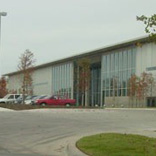The new building for the Modern Art Museum of Fort Worth opened to the public on December 14, 2002. It is 153,000 square feet, on an 11-acre plot located across the street from the Kimbell Art Museum. Japanese architect Tadao Ando was the architect.
According to artist Ellsworth Kelly, “The architect of a museum has the responsibility to leave or create spaces necessary for the artist. In an art museum project, therefore, architecture and art must be considered at the same time.” It’s a tall order. A rounder way of describing the museum architect’s job would be: adorn the city with a proud building, attract the population into an easy-to-understand shelter where cultural exposure can be had, and do both subtly, so that the art itself shimmers forth as the actual destination. A successful museum is a stealth performance.
The new Fort Worth Modern meets this tall order and then some. It is a simple, pristine space for viewing art, but its organization is also dramatic and engaging enough to ward off spatial boredom. Ando’s building is not a showboat. It is tranquil and inviting. It also respectfully acknowledges the Louis Kahn-designed Kimbell next door. Built 30 years ago, the Kimbell etches into the landscape a series of long, barrel-vaulted pavilions that suggest the stunning plenty of horizons in Texas. Ando’s pavilions also go long, and reach up with their tall, glazed verticality.
The materials of the Modern belie the preciousness of the works within. The exterior is made of bead-blasted aluminum panels that were machined in Holland, anodized in Wisconsin, and cut and assembled in Kansas City. Counter tops are South African granite. In order to create the smooth cast-in-place concrete walls, tons of ice and chilled water were put into the concrete mix.
The Modern is comprised of five glass pavilions, each of which has flat roofs supported by 40″ Y-shaped concrete columns. The main entrance is through the long side of the southernmost pavilion, and the organization of the interior spaces is self-evident: to the right are the auditorium and restaurant, straight ahead is a large placid pond around which the museum unfurls, and to the left are the shop and the entrance to the galleries.
To the left, the large glass pavilion contains smaller solid boxes that are the gallery spaces. This box-within-a-box organization creates mazelike corridors and interstices through which the viewer choses how to proceed from gallery to gallery. Unlike Herzog and de Meuron’s Tate Modern in London, where strings of oddly-sized galleries lead to escalators, which lead to more strings of galleries with an occasional tiny terrace overlooking the Thames, all ending in an escalator, Ando gave the Modern a more varied circulation scheme. Also, the spatial culmination of The Modern is not a single note (as in Rafael Moneo’s Museum of Fine Arts, Houston Beck building, the highlight of which is an enormous, donor-encrusted egress stairwell). Ando’s Modern is a loop of jewel-like gallery spaces, with a grand stair at the south end and a narrow stair at the north completing the loop. Galleries are destinations within this loop and the art within them becomes the purpose for entering.
The long, narrow north stair is a dramatic experience. With a glass exterior wall on one side and a solid interior wall on the other, this stairwell protracts the sensation of midwayness between outside and inside, which is a central theme of the entire building.
Looking at the volume of art a museum can display is exhausting without rest and refocus. What is the best way to go from a room of Philip Guston to a room of Sean Scully? How can the palette be cleansed? Architecture. Rather than using repetitive, department store escalators, or copying the floorplans of old palace museums in Europe, Ando uses light, boundaries, and views to the exterior to give passage and re-orientation, so the viewer can forge ahead cleanly to more art experiences. The many views of the placid landscape outside (both of the Modern’s cleanly manicured acreage and of Fort Worth beyond) are pockets of respite for the viewer, all sequenced carefully within the loop of galleries.
It is difficult to consider a new museum outside of the context of recent pricey, controversial structures, the $126 million Beck building in Houston being a notable local example. Extensive has been the discussion as to these buildings” success as structures for viewing art, for attracting visitors to the museums and their communities, and as diversions for funds that might otherwise go toward collections of artwork. With a relatively modest cost of $65 million, and a design that enhances viewing the artwork, the Modern succeeds in the stealth performance required of it. Art needs architecture. In Ando’s building this relationship is described quietly and perfectly.



